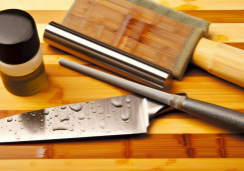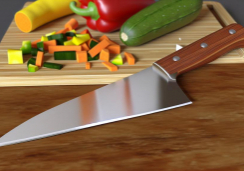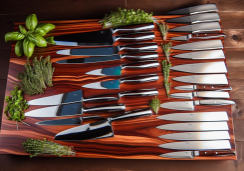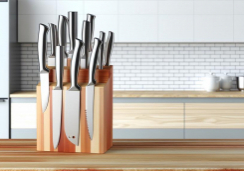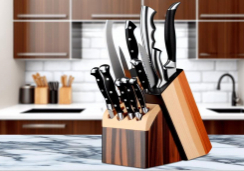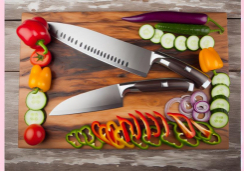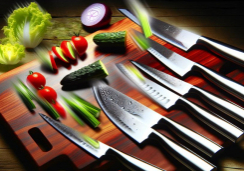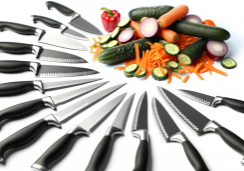Why Choose High-Carbon Steel Knives for Your Kitchen?
Imagine you've just splurged on a premium set of knives, and within months, you're noticing a decline in performance; it's a frustrating experience many face, but one that could be mitigated with high-carbon steel knives.
You're likely seeking tools that provide lasting sharpness, durability, and an ease of maintenance that doesn't require a degree in metallurgy. High-carbon steel knives offer these qualities, setting themselves apart from their lower-carbon counterparts. They're designed to take and hold a finer edge, ensuring that the tomatoes you slice maintain their integrity slice after slice.
However, as with any choice worth making, there are considerations to weigh, such as care and proper usage, to prevent rust and ensure longevity.
As you contemplate the value these knives could bring to your culinary endeavors, you'll want to understand the full spectrum of their benefits and how they could elevate your cooking to professional standards.
Benefits of High-Carbon Steel
High-carbon steel knives offer unparalleled edge retention and sharpness, making them a superior choice for precision cutting tasks in your kitchen. The carbon content in these knives, typically ranging between 0.6% and 1.0%, directly enhances their hardness. This increased hardness translates to a finer and more acute edge, which you'll notice as you glide through ingredients with minimal effort.
You'll also appreciate the durability of high-carbon steel. It resists wear and tear better than its lower-carbon counterparts, ensuring that your knife withstands the rigors of daily use. However, it's worth noting that this type of steel demands a certain level of care. You must keep it dry and oiled to prevent rust and corrosion, a small trade-off for its exceptional performance.
Furthermore, high-carbon steel allows for easier sharpening. When the time comes to hone the edge, you'll find the process less laborious, enabling you to maintain a razor-sharp edge with regular upkeep.
The combination of edge retention, sharpness, durability, and ease of maintenance makes high-carbon steel knives not just a tool but a long-term investment in your culinary arsenal. Choose them for their technical excellence and watch how they elevate your cooking precision.
Sharpening Your Kitchen Knives
While your high-carbon steel knives retain their edge longer, regular sharpening is still essential to maintain optimum performance in your culinary tasks. Sharp blades reduce the risk of accidents, improve cutting precision, and decrease the effort required. Here's how you can keep your knives in top condition:
- Choose the right sharpening tools. A whetstone, preferably with dual grits, is ideal for high-carbon steel. The coarser side grinds down any nicks or unevenness, while the finer side hones the edge to razor sharpness.
- Maintain the correct angle. Hold the knife at a 15 to 20-degree angle relative to the whetstone. This acute angle is crucial for achieving the fine edge that high-carbon steel is capable of sustaining.
- Use consistent strokes. Glide the blade across the stone in smooth, even strokes, covering the entire length of the edge. Typically, 10 strokes per side should suffice, but assess the blade's sharpness periodically and continue until satisfied.
- Strop for refinement. After sharpening, use a leather strop to align the microscopic teeth on the knife's edge, further enhancing its sharpness and polish.
Preventing Rust and Corrosion
To safeguard your investment and ensure the longevity of your knives, it's crucial to prevent rust and corrosion through proper maintenance and storage. High-carbon steel knives are particularly susceptible to these issues due to the material's reactivity with moisture and acidic substances.
Firstly, always clean your knives immediately after use. Hand wash them with a mild detergent and warm water, then thoroughly dry with a soft towel. Avoid letting them soak or leaving them wet, as prolonged exposure to water catalyzes oxidation.
Next, apply a thin layer of food-grade mineral oil to the blade. This barrier protects the steel from moisture and acidic elements that can cause corrosion. Ensure you cover the entire surface, then wipe off any excess to prevent a greasy residue.
For storage, use a knife block, magnetic strip, or sheath that allows air circulation. Sheaths should be made of breathable materials to prevent moisture accumulation. Never store knives in a drawer unprotected, where they can knock against other utensils, damaging the blade and creating micro-abrasions where rust can form.
Lastly, consider using a dehumidifier in your kitchen or storage area if you live in a humid environment, as this will help to keep the air dry and further protect your knives from rust and corrosion.
Proper Knife Storage Solutions
Ensuring your high-carbon steel knives have a proper place in your kitchen not only helps maintain their sharpness but also prevents potential safety hazards. Proper storage is critical to preserving the integrity of your knives' edges and preventing accidental injuries.
Here's how you can keep your high-carbon steel knives in impeccable condition:
- Magnetic Knife Strip: A magnetic strip mounted on the wall serves as an accessible and safe storage solution. It keeps knives dry, visible, and spread out, preventing contact with other utensils that could dull the blades.
- Knife Block: Opt for a knife block with horizontal slots to minimize blade contact with the wood, which can dull edges over time. Ensure the block is made of softwood and the knives are fully dry before storage to avoid corrosion.
- Knife Roll: A knife roll made from sturdy fabric or leather offers a portable option that protects each knife in individual sleeves. It's essential for professionals or those who frequently transport their knives.
- In-Drawer Trays: These trays feature designated slots for each knife, keeping them securely separated. Ensure the tray is made from a soft material to prevent dulling and choose a design that allows air circulation to avoid moisture buildup.
Cleaning and Maintenance Tips
Maintaining the pristine condition of your high-carbon steel knives requires regular cleaning and careful attention to detail. After each use, immediately hand wash your knife with warm soapy water to prevent food particles from clinging and acids from corroding the blade. Dry it thoroughly with a soft towel; moisture is the enemy, as it can lead to rust development on high-carbon steel.
For stubborn residues, use a gentle scrubbing pad, avoiding harsh scouring materials that can scratch your knife's surface. If discoloration or rust spots do occur, a specialized knife cleaner or a mixture of baking soda and water can be applied. Rub the affected area gently with a non-abrasive cloth, then rinse and dry promptly.
Lubricate the blade with food-safe mineral oil to create a protective barrier against moisture and corrosion. Perform this action regularly, depending on usage frequency and storage conditions.
Sharpening your high-carbon steel knives is also crucial; use a whetstone or honing rod to maintain a sharp edge, and always follow the manufacturer's angle guidelines.
Can High-Carbon Steel Knives Help Extend the Lifespan of Kitchen Knives?
High-carbon steel knives are durable and can help prolong the lifespan of kitchen knives. To extend kitchen knives longevity, it’s essential to invest in good quality knives that can withstand daily use. Proper maintenance and regular sharpening are also vital kitchen knives longevity tips to keep them in top condition.
Conclusion
You've learned why high-carbon steel knives are superior: their exceptional edge retention and ease of sharpening set them apart.
However, to ensure longevity, prevent rust by keeping them dry and oiling them regularly.
Store them properly to maintain their sharpness.
With meticulous cleaning and maintenance, your high-carbon steel knives will be reliable culinary partners.
Embrace the discipline of care, and these tools will reward you with precision and durability in your kitchen endeavors.

